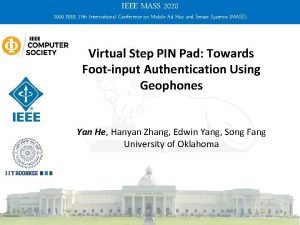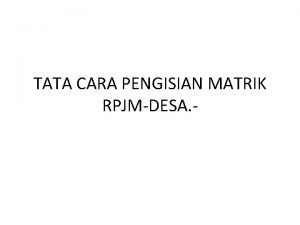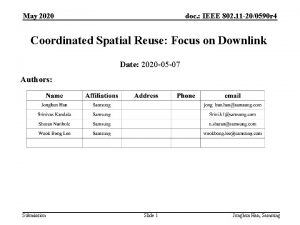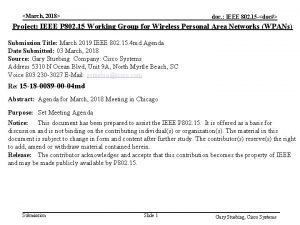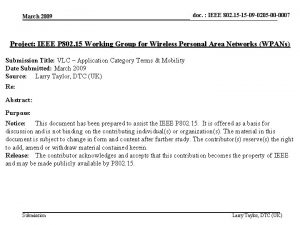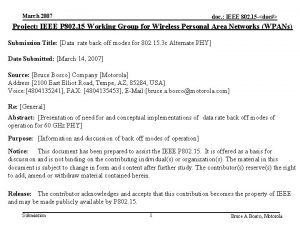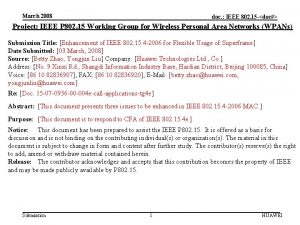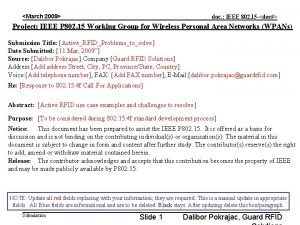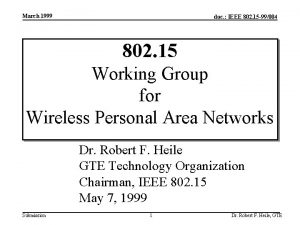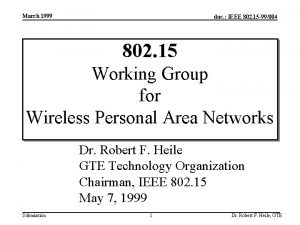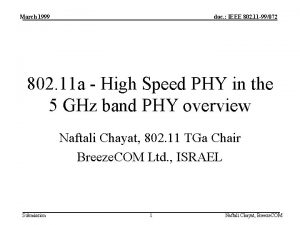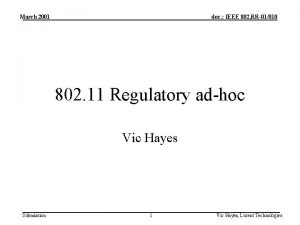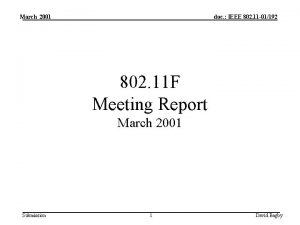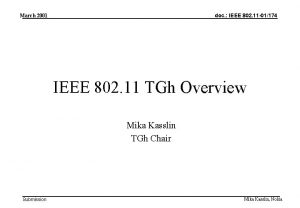March 2020 doc IEEE 802 11 200590 r












![March 2020 doc. : IEEE 802. 11 -20/0590 r 0 Reference [1] 802. 11 March 2020 doc. : IEEE 802. 11 -20/0590 r 0 Reference [1] 802. 11](https://slidetodoc.com/presentation_image_h2/f4e98c6597661596680cfa5ad800484f/image-13.jpg)



- Slides: 16

March 2020 doc. : IEEE 802. 11 -20/0590 r 0 Coordinated Spatial Reuse: Focus on Downlink Date: 2020 -05 -07 Authors: Submission Slide 1 Jonghun Han, Samsung

March 2020 doc. : IEEE 802. 11 -20/0590 r 0 Recap: Coordinated SR (C-SR) • C-SR is a simple Multi-AP transmission that can increase spectrum efficiency by reusing the same time/frequency resources among multiple BSSs • C-SR procedure – C-SR procedure with unsolicited method [1] – General C-SR procedure [2] • C-SR performance gain – Compared to OBSS-PD and TDD [3] – Compared to EDCA and complete control [4] – Compared to C-OFDMA and OBSS-PD [5] • In this contribution, we divide the downlink (DL) C-SR procedure into 3 phases and investigate some issues in C-SR operation Submission Slide 2 Jonghun Han, Samsung

March 2020 doc. : IEEE 802. 11 -20/0590 r 0 AP Issue 1: C-SR Coordination Policy • • DL TX C-SR gain comes from appropriate Tx power management Sharing AP Option 1: bi-directional coordination – Sharing AP and shared AP negotiate the appropriate Tx power combination – Could be better in terms of sum throughput – Additional signaling overhead – Scalability • STA Shared AP Negotiated power Enough power Option 2: one-way coordination (Preferred) – Sharing AP determines Tx power without a coordination process and limits the Tx power of shared AP to protect transmissions of sharing AP – Encouraging sharing AP to share its TXOP – Simple, scalable Submission Slide 3 Sharing AP Shared AP Less power Jonghun Han, Samsung

March 2020 doc. : IEEE 802. 11 -20/0590 r 0 C-SR Procedure into 3 Phases • 1 3 AP 1 AP 2 AP STA Signal 2 Submission Slide 4 4 Jonghun Han, Samsung

March 2020 doc. : IEEE 802. 11 -20/0590 r 0 C-SR Procedure into 3 Phases 2. Announcement phase: after AP obtains TXOP – If the AP is willing to share the obtained TXOP, it becomes a sharing AP – Sharing AP’s action list • Select the shared AP from the potential shared APs – To minimize DL interference from the shared AP • Trigger the shared AP’s transmission using announcement frame – Essential information: AP ID, Tx power limit 3. Transmission phase: after the potential shared AP obtains the shared TXOP – If a potential shared AP receives the announcement frame successfully and has willing to participate in the C-SR transmission, the AP becomes a shared AP – Shared AP’s action list • Set Tx power based on the guide obtained from the announcement frame – C-SR transmissions (including block acknowledgement) of the sharing/shared APs occur simultaneously in the shared TXOP – Assumption: start/end time of C-SR transmissions are aligned Submission Slide 5 Jonghun Han, Samsung

March 2020 doc. : IEEE 802. 11 -20/0590 r 0 C-SR Procedure Example: 2 -BSS DL/DL • AP 1 obtains TXOP sharing AP AP 1 STA 1 -2 Collecting Capability/RSSI • AP 2 obtains the shared TXOP shared AP C-SR-A DL BA Collecting Measurement Report BA DL-SAP AP 2 BA STA 2 -1 BA STA 2 -2 Preparation Phase Announcement Phase Transmission Phase * C-SR-A: C-SR announcement frame *DL-SAP: Downlink transmission of shared AP Submission Slide 6 Jonghun Han, Samsung

March 2020 doc. : IEEE 802. 11 -20/0590 r 0 Issue 2: Contents of Announcement Frame • Function of Announcement frame – Indication of C-SR procedure start (Reservation of medium) • Followed by sharing AP’s transmission – Soliciting transmission of shared AP • Essential contents of announcement frame – Common info • Multi-AP coordination type (C-SR) – Per-AP info for each shared AP • AP identifier • Tx power limit • Non-overlapping frequency resource allocation for block acknowledgement info (to be explained in the following slides) Submission Slide 7 Jonghun Han, Samsung

March 2020 doc. : IEEE 802. 11 -20/0590 r 0 Issue 3: Block Acknowledgement (BA) Separation • Problem – Tx power limit applies only for shared AP’s DL transmission – STAs’ BA transmission will interfere each other • Options for BA separation – [Option 1] Non-overlapping resources for BA (preferred) • Allocate non-overlapping frequency resources for BAs of sharing/shared BSS* • Non-overlapping frequency resource allocation for BA is determined by the sharing AP and included in the announcement frame • Pros: low overhead • Cons: RU assignment required, UL power control required – [Option 2] Implicit BA for sharing BSS, and delayed BA for shared BSS • Pros: simple • Cons: overhead * Sharing BSS: BSS that sharing AP belongs to * Shared BSS: BSS that shared AP belongs to Submission Slide 8 Jonghun Han, Samsung

March 2020 doc. : IEEE 802. 11 -20/0590 r 0 Issue 3: Block Acknowledgement (BA) Separation • [Option 1] Non-overlapping resources for BA in detail – Two-level BA separation • Level 1: BA separation among sharing/shared BSSs – 20 MHz granularity separation using announcement frame • Level 2: BA separation between DL STAs in each BSS (DL MU PPDU case) frequency – STAs receives Qo. S data frame within HE MU PPDU – STAs send the immediate response according to the resource allocation information that is carried in the TRS control subfield BA of STA 1 80 MHz C-SR Transmission of sharing AP (DL MU PPDU) 3 BA of STA 2 Shared AP SIFS 1 same 80 MHz time frequency 4 Sharing AP 80 MHz C-SR Transmission of shared AP (DL MU PPDU) 2 BA of STA 3 BA of STA 4 Submission Slide 9 time Jonghun Han, Samsung

March 2020 doc. : IEEE 802. 11 -20/0590 r 0 Summary • We divide C-SR procedure into 3 phases according to TXOP acquisition status of sharing/shared AP and clarify the list of things to do in each phase • We believe that one-way coordination is an appropriate policy to manage the Tx power in C-SR operation • We investigate the contents of announcement frame • We propose two options for BA separation Submission Slide 10 Jonghun Han, Samsung

March 2020 doc. : IEEE 802. 11 -20/0590 r 0 Straw Poll #1 • Do you agree that in 11 be sharing AP limits the shared AP’s transmission power during the shared TXOP for C-SR operation? Submission Slide 11 Jonghun Han, Samsung

March 2020 doc. : IEEE 802. 11 -20/0590 r 0 Straw Poll #2 • Do you agree that in 11 be sharing AP allocates non-overlapping frequency resources of block acknowledgements for each sharing AP and shared AP(s) for C-SR operation? – Allocating non-overlapping frequency resource shall be determined by sharing AP – The way of indicating non-overlapping frequency resources for block acknowledgement is TBD Submission Slide 12 Jonghun Han, Samsung
![March 2020 doc IEEE 802 11 200590 r 0 Reference 1 802 11 March 2020 doc. : IEEE 802. 11 -20/0590 r 0 Reference [1] 802. 11](https://slidetodoc.com/presentation_image_h2/f4e98c6597661596680cfa5ad800484f/image-13.jpg)
March 2020 doc. : IEEE 802. 11 -20/0590 r 0 Reference [1] 802. 11 -20/0410 r 4 [2] 802. 11 -20/0576 r 0 [3] 802. 11 -20/0457 r 1 [4] 802. 11 -20/0107 r 1 [5] 802. 11 -20/0073 r 0 Submission Slide 13 Jonghun Han, Samsung

March 2020 doc. : IEEE 802. 11 -20/0590 r 0 APPENDIX Submission Slide 14 Jonghun Han, Samsung

March 2020 doc. : IEEE 802. 11 -20/0590 r 0 Passed Motions related to C-SR Operation ① 11 be shall define a mechanism to determine whether an AP is part of an AP candidate set and can participate as a shared AP in coordinated AP transmission initiated by a sharing AP. ② Define a procedure for an AP to share its frequency/time resources of an obtained TXOP with a set of APs ③ An AP that intends to use the resource (i. e. , frequency or time) shared by another AP shall be able to indicate its resource needs to the AP that shared the resource. ④ In all modes of operation wherein an AP shares its frequency/time resource of an obtained TXOP with a set of APs, – Define a mechanism for the sharing AP to optionally solicit feedback from one or more APs from the AP candidate set to learn the resource needs and the intend to participate in a coordinated AP transmission. Submission Slide 15 Jonghun Han, Samsung

March 2020 doc. : IEEE 802. 11 -20/0590 r 0 Passed Motions related to C-SR Operation ⑤ In all modes of operation wherein an AP shares its frequency resource with a set of APs, the AP shall share its frequency resource in multiples of 20 MHz channels with a set of APs in an obtained TXOP? – PPDU format of the transmission on the shared resource is TBD ⑥ Do you support to introduce a coordinated spatial reuse operation in TGBe? – Whether it is in R 1 or R 2 is TBD. Submission Slide 16 Jonghun Han, Samsung
 Bridges from 802.x to 802.y
Bridges from 802.x to 802.y Bridges from 802.x to 802.y
Bridges from 802.x to 802.y Anthem of poland
Anthem of poland Estandares 802
Estandares 802 802 ieee
802 ieee Ieee 802 family
Ieee 802 family Ieee802.22
Ieee802.22 Ieee 802 standard
Ieee 802 standard Ieee 802
Ieee 802 Ieee 802 3 compliance
Ieee 802 3 compliance Arquitetura ieee 802
Arquitetura ieee 802 Bluetooth ieee 802
Bluetooth ieee 802 Ieee mass 2020
Ieee mass 2020 Format rps dikti 2021 doc
Format rps dikti 2021 doc Format matrik rpjm desa
Format matrik rpjm desa Oświadczenie o wypadku w pracy
Oświadczenie o wypadku w pracy Mac address
Mac address












